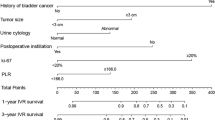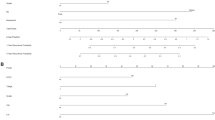Abstract
Background
The aim of this study was to identify the clinical predictors related to the risk of high-grade papillary bladder cancer before first-time transurethral resection of a bladder tumor (TUR-Bt), and to develop and validate a nomogram predicting the risk of high-grade papillary bladder cancer.
Methods
A retrospective clinical study of consecutive patients who underwent first-time TUR-Bt for papillary bladder cancer was performed. Medical records were reviewed uniformly, and the following data were collected: age, sex, episodes of urinary symptoms, tumor size, number of tumors, location of the largest tumor (lateral walls, base, posterior wall, dome, and anterior wall), tumor appearance (papillary or non-papillary, pedunculated or sessile), and urinary cytology. Data from 254 patients (Group A) were used for the development of a nomogram, while data from 170 patients (Group B) were used for its external validation.
Results
High-grade papillary bladder cancer was pathologically diagnosed in 51.6 and 74.6% of Group A and Group B patients, respectively. Based on univariable analyses in Group A, macrohematuria, tumor size, multiple tumors, appearance, and positive urinary cytology were selected as variables to incorporate into a nomogram. The AUC value was 0.81 for the internal validation (Group A), and 0.78 for the external validation (Group B). This novel nomogram can predict high-grade papillary bladder cancer accurately.
Conclusions
The present nomogram can help clinicians calculate the probability in patients with bladder cancer before TUR-Bt and decide on earlier intervention and priorities for the treatment of patients diagnosed with bladder cancer.


Similar content being viewed by others
References
Matsuda T, Okuyama A (2017) Incidence rate for bladder cancer in Japanese in Japan and in the United States from the Cancer Incidence in Five Continents. Jpn J Clin Oncol 47:284–285
Kamiya N, Suzuki H, Suyama T et al (2017) Clinical outcomes of second transurethral resection in non-muscle invasive high-grade bladder cancer: a retrospective, multi-institutional, collaborate study. Int J Clin Oncol 22:353–358
Nishiyama H (2017) Asia Consensus Statement on NCCN Clinical Practice Guideline for bladder cancer. Jpn J Clin Oncol 14:1–4
Klaassen Z, Soloway MS (2017) European Association of Urology and American Urological Association/Society of Urologic Oncology Guidelines on risk categories for non-muscle-invasive bladder cancer may lead to overtreatment for low-grade Ta bladder tumors. Urology 105:14–17
Fernandez-Gomez J, Madero R, Solsona E et al (2009) Predicting nonmuscle invasive bladder cancer recurrence and progression in patients treated with bacillus Calmette–Guerin: the CUETO scoring model. J Urol 182:2195–2203
Kluth LA, Xylinas E, Crivelli JJ et al (2013) Obesity is associated with worse outcomes in patients with T1 high grade urothelial carcinoma of the bladder. J Urol 190:480–486
Shapur N, Pode D, Katz R et al (2011) Predicting the risk of high-grade bladder cancer using noninvasive data. Urol Int 87:319–324
Van Rhijin BW, Burger M, Lotan Y et al (2009) Recurrence and progression of disease in non-muscle-invasive bladder cancer: from epidemiology to treatment strategy. Eur Urol 56:430–442
Miyake M, Gotoh D, Shimada K et al (2015) Exploration of risk factors predicting outcomes for primary T1 high-grade bladder cancer and validation of the Spanish Urological Club for Oncological Treatment scoring model: long-term follow-up experience at a single institute. Int J Urol 22:541–547
Sauter G, Algaba F, Amin M et al (2004) Tumors of the urinary system: noninvasive urothelial neoplasias. In: Eble JN, Sauter G, Epstein JI Sesterhenn I WHO Classification of tumours of the urinary system and male genital organs. IARCC Press, Lyon
MacLennan G, Kirkali Z, Cheng L et al (2007) Histologic grading of noninvasive papillary urothelial neoplasms. Eur Urol 51:889–898
Mariappan P, Lavin V, Phua CQ et al (2017) Predicting grade and stage at cystoscopy in newly presenting bladder cancers-a prospective double-blind clinical study. Urology 109:134–139
Wakai K, Utsumi T, Oka R et al (2016) Clinical predictors for high-grade bladder cancer before first-time transurethral resection of the bladder tumor: a retrospective cohort study. Jpn J Clin Oncol 46:964–967
Sobin LH, Gospodariwicz M, Wittekind C (2009) TNM classification of malignant tumors. UICC International Union against Cancer, 7th edn. Wiley-Blackwell, Hoboken, pp 262–265
Utsumi T, Kamiya N, Endo T et al (2014) Development of a novel nomogram to predict hypertension cure after laparoscopic adrenalectomy in patients with primary aldosteronism. World J Surg 38:2640–2644
Utsumi T, Kamiya N, Kaga M et al (2017) Development of novel nomograms to predict renal functional outcomes after laparoscopic adrenalectomy in patient is with primary aldosteronism. World J Urol 35:1577–1583
Kirkali Z, Chan T, Manoharan M et al (2005) Bladder cancer: epidemiology, staging and grading, and diagnosis. Urology 66:4–34
Iida S, Kondo T, Kobayashi H et al (2009) Clinical outcome of high-grade non-muscle-invasive bladder cancer: a long-term single center experience. Int J Urol 16:287–292
Damrauer JS, Hoadley KA, Chism DD et al (2014) Intrinsic subtypes of high-grade bladder cancer reflect the hallmarks of breast cancer biology. Proc Natl Acad Sci USA 111:3110–3115
Morgan TM, Keegan KA, Clark PE (2011) Bladder cancer. Curr Opin Oncol 23:275–282
Sylvester RJ, van der Meijden AP, Oosterlinck W et al (2006) Predicting recurrence and progression in individual patients with stage Ta T1 bladder cancer using EORTC risk tables: a combined analysis of 2596 patients from seven EORTC trials. Eur Urol 49:466–467
Avritscher EB, Cooksley CD, Grossman HB et al (2006) Clinical model of lifetime cost of treating bladder cancer and associated complications. Urology 68:549–553
Miyamoto H, Miller JS, Fajardo DA et al (2010) Noninvasive papillary urothelial neoplasms: the 2004 WHO/ISUP classification system. Pathol Int 60:1–8
Gontero P, Gillo A, Fiorito C et al (2014) Prognostic factors of ‘high-grade’ ta bladder cancers according to the who 2004 classification: are these equivalent to ‘high-risk’ non-muscle-invasive bladder cancer? Urol Int 92:136–142
Dekalo S, Matzkin H, Mabjeesh NJ. (2017) Can urologists accurately stage and grade urothelial bladder cancer by assessing endoscopic photographs? J Telemed Telecare. https://doi.org/10.1177/1357633X17727773
Extermann M, Hurria A (2007) Comprehensive geriatric assessment for older patients with cancer. J Clin Oncol 25:1824–1831
Masaoka H, Matsuo K, Ito H et al (2016) Cigarette smoking and bladder cancer risk: an evaluation based on a systematic review of epidemiologic evidence in the Japanese population. Jpn J Clin Oncol 46:273–283
Panebianco V, Barchetti F, de Haas RJ et al (2016) Improving staging in bladder cancer: the increasing role of multiparametric magnetic resonance imaging. Eur Urol Focus 2:113–121
Funding
None.
Author information
Authors and Affiliations
Corresponding author
Ethics declarations
Conflict of interest
Hiroyoshi Suzuki has received paid consulting from Nippon Kayaku, Takeda, Astellas, Daiichi-Sankyo, and Pfizer.
Electronic supplementary material
Below is the link to the electronic supplementary material.
10147_2018_1299_MOESM1_ESM.tif
Supplementary Fig. 1. Calibration plots with local regression non-parametric smoothing lines of the present nomograms on internal validation (a) and external validation (b). X-axis, probability of high-grade papillary bladder cancer predicted by the nomogram; Y-axis, actual proportion. Perfect prediction corresponds to a 45° line. Values above and below the 45° line represent underestimation and overestimation, respectively (TIF 274 KB)
About this article
Cite this article
Wakai, K., Utsumi, T., Yoneda, K. et al. Development and external validation of a nomogram to predict high-grade papillary bladder cancer before first-time transurethral resection of the bladder tumor. Int J Clin Oncol 23, 957–964 (2018). https://doi.org/10.1007/s10147-018-1299-y
Received:
Accepted:
Published:
Issue Date:
DOI: https://doi.org/10.1007/s10147-018-1299-y




